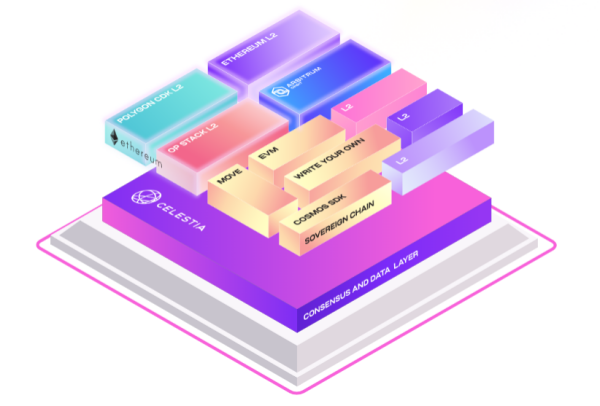
In today's era of rapid development of blockchain technology, Celestia, as a modular data availability network, is leading the trend of a new generation of scalable blockchain architecture. Celestia achieves the goal of secure expansion as the number of users grows by separating execution from consensus and introducing a new primitive for data availability sampling. This innovation makes it easy for anyone to start their own blockchain.
Celestia's Core Technology
The core of Celestia's technology lies in two aspects: separation of execution from consensus and data availability sampling. The former means that Celestia is only responsible for sorting transactions and ensuring their data availability, which is similar to simplifying consensus to atomic broadcast. The latter provides an efficient solution by only requiring light nodes with limited resources to randomly sample a small amount of shared data from each block to verify data availability.
Data Availability Sampling
The subtlety of the data availability sampling technology is that as the number of light nodes participating in the sampling increases, the amount of data that the network can safely process also increases, allowing the block size to increase without significantly increasing the cost of verifying the chain. This mechanism greatly improves the scalability of the system.
Monolithic blockchain vs. modular blockchain
Blockchain is essentially a replication state machine: in a permissionless distributed network, nodes apply a series of ordered deterministic transactions to the initial state to reach a common final state. In other words, this means that the nodes in the network all follow the same set of rules (i.e., an ordered sequence of transactions) to get from the starting point (i.e., the initial state) to the end point (i.e., the common final state). This process ensures that all nodes in the network agree on the final state of the blockchain when operating independently.
Limitations of Monolithic Blockchain
Traditional monolithic blockchains integrate the four functions of execution, settlement, consensus, and data availability into a basic consensus layer. The problem with monolithic blockchains is that the consensus layer must perform a variety of different tasks and cannot be optimized for a single function, resulting in limited system throughput.
Advantages of Modular Blockchain
As a solution, modular blockchains separate these functions in multiple specialized layers to form a modular stack. Due to the flexibility provided by specialization, this stack can be arranged in many ways. For example, one arrangement is to divide the four functions into three specialized layers: the base layer consists of data availability and consensus, so it is called the consensus and data availability layer.
Celestia's modular architecture
Celestia's modular architecture brings significant flexibility and scalability by separating the four functions of execution, settlement, consensus, and data availability. Specifically, Celestia's architecture can be divided into the following layers:
Consensus and data availability layer: responsible for the ordering of transactions and the availability of data.
Settlement layer: provides an environment for the execution layer to verify proofs, resolve fraud disputes, and bridge between other execution layers.
Execution layer: executes transactions that update the state, ensuring that only valid transactions are executed, that is, those that result in valid state machine transitions.
Flexible modular design
This modular design allows different layers to focus on their respective functions, thereby optimizing the performance of each layer. For example, the consensus and data availability layer can focus on improving data processing capabilities without having to worry about the complexity of the execution layer. Similarly, the settlement layer can focus on verification and dispute resolution without having to bear the responsibility of data availability.
Application prospects of Celestia
Celestia's modular design not only improves the scalability and flexibility of the system, but also provides broad application prospects for the further development of blockchain technology. The following are several possible application scenarios:
Customized blockchain: Anyone can easily start and customize their own blockchain based on Celestia's modular architecture. This provides unprecedented convenience for enterprises and developers.
Cross-chain interoperability: Through the bridging function of the settlement layer, efficient interoperability can be achieved between different blockchains, promoting the integration and development of the blockchain ecosystem.
Efficient data processing: Data availability sampling technology enables blockchain systems to process larger amounts of data without significantly increasing verification costs, which is particularly important for large-scale application scenarios.
Conclusion
Celestia is leading a new trend in blockchain technology through its modular data availability network and innovative technical architecture. It not only solves the limitations of traditional single blockchains, but also provides unlimited possibilities for future blockchain applications. With more light nodes participating in data sampling, Celestia's scalability will be further improved, laying a solid foundation for the widespread application of blockchain technology.
In short, the emergence of Celestia marks a new era for blockchain technology, and its modular design and data availability sampling technology will have a profound impact on the future development of blockchain.